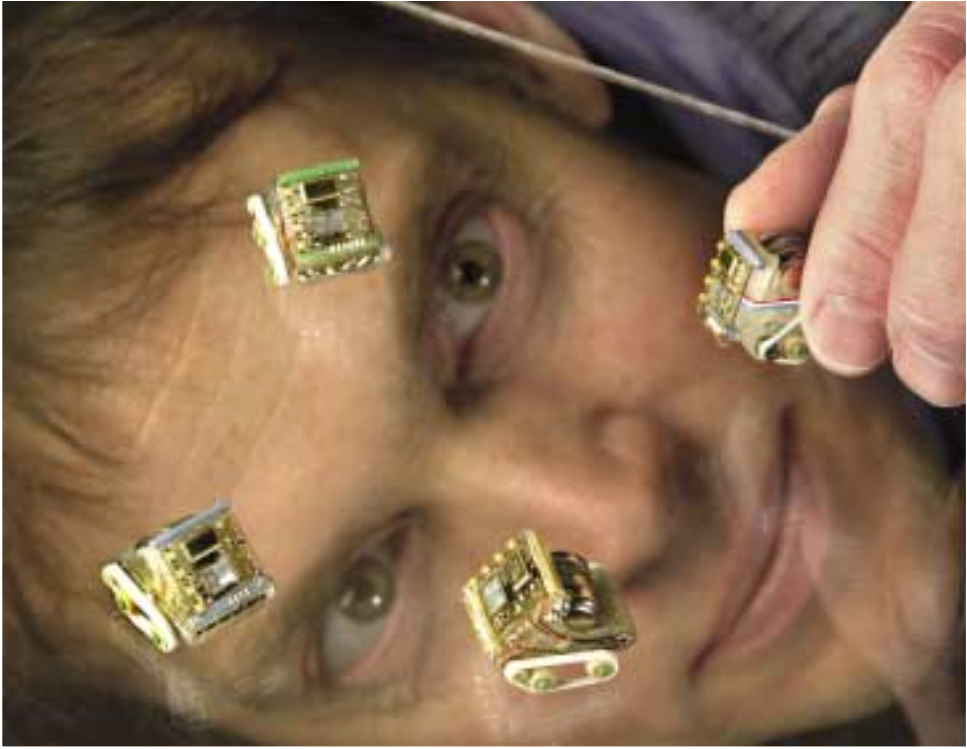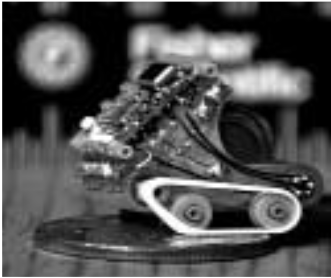Robot described as being able to ‘turn on a dime and park on a nickel’
What may be the world’s smallest robot — it “turns on a dime and parks on a nickel” — is being developed by Sandia researchers. At 1/4 cubic inch and weighing less than an ounce, it is possibly the smallest autonomous un-tethered robot ever created. Powered by three watch batteries, it rides on track wheels and consists of an 8K ROM processor, temperature sensor, and two motors that drive the wheels. Future enhancements being considered include a miniature camera,microphone, communication device, and chemical micro-sensor.“This could be the robot of the future,” says Ed Heller (1763), one of the project’s researchers. “It may eventually be capable of performing difficult tasks that are done with much larger robots today — such as locating and disabling land mines or detecting chemical and biological weapons.” He says it could, for example, scramble through pipes or prowl around buildings looking for chemical plumes or human movement.
The robots may be capable of relaying information to a human-manned station and communicating with each other. They will be able to work together in swarms like insects. The mini-robot has already successfully maneuvered its way through a field of dimes and nickels and travels at about 20 inches a minute. It can sit comfortably on a nickel. The newest mini-robot research continues work started in Intelligent Systems Sensors & Controls Dept. 15211 by Perry Molley (now 2331),Tom Webber, and others. In 1996 the department unveiled a Mini Autonomous Robot Vehicle (MARV), a one-cubic-inch robot that contained all the necessary power, sensors, computers, and controls on board. It was made primarily from commercial parts using conventional machining techniques.Over the next several years the department improved the original MARV and in September1999 delivered 36 mini-robots to the Defense Advanced Research Projects Agency (DARPA).

The robots’ bodies were made of printed circuit boards, and each had an obstacle detector sensor, radio, temperature sensor, and batteries. At1.6 x 0.75 x 0.71 inches, they were much larger than the mini-robots being developed now. Ray Byrne (15211), who was involved in the DARPA project,says about three years ago Intelligent Systems and Robotics Center15200 teamed with Sandia’s Sensor Technologies Dept. 1744 to further miniaturize the robots. They sought out Dept. 1744’s help because of its expertise in building sensors and other devices on miniature scales. By trying new techniques in packaging electronics, wheel design, and body material, the new team of researchers has already shrunk the robots to 1/4 cubic inch.
Ed, who developed the device’s microelectronics, says one significant innovation that permitted the shrinkage was the use of commercially available unpackaged electronics parts. “Previous small robots consisted of packaged electronic parts which were more bulky and took up valuable space. By eliminating the packaging and using electronic components in die form, we reduced the size of the robots’ electronics considerably,” Ed says. “This was a first major step.”The unpackaged parts are assembled onto a simple multi-chip module on a glass substrate.The assembly was done at Sandia’s Compound Semiconductor Research Laboratory.Doug Adkins (1763), who developed the mechanical design for the new mini-robot, says the robot’s size was further reduced by using anew rapid prototyping technique to form the device’s body.

Called stereo lithography, the material-building method lays down a very thin polymer deposit that is cured by a laser. The material, which “grows” as each layer is added,is lightweight, strong, and can be formed in complex shapes. The robot bodies, which were manufactured by Daryl Reckaway in Dept.14184, have cavities for the batteries, the electronics-embedded glass substrate, axles, tiny motors, switches, and other parts.Doug also redesigned the wheel structure of the device. Earlier models had standard four wheels. However, the mobility was limited due to the small size of the wheels. “I thought of how tanks with their track wheels can maneuver over many large objects and realized the mini-robots could benefit from the same type of wheels,” Doug says.
With the addition of tracks, the robot can now move easily on carpet.The ultimate size of the miniature robots is primarily limited by the size of the power source— the three watch batteries. The body must be large enough to hold the batteries to support the power requirements of the robot.“Batteries — both the physical size and battery life — have been one of our biggest issues,”Ed says. “The batteries need to run longer and be smaller.”Over the next few years, with additional help from other groups in 1700, Ed and Doug expect to add to the mini-robots either infrared or radio wireless two-way communication capability, as well as miniature video cameras, micro-phones, and chemical micro-sensors.